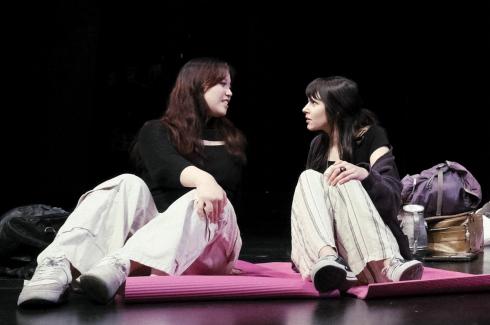The director, cast and crew share their experiences creating the play
By GRACIELA TIU — features@theaggie.org
On Thursday, Feb. 27 at 7 p.m., the UC Davis Department of Theatre and Dance’s production of the play “Small Mouth Sounds” will have its opening night. The show, taking place at the Wyatt Pavilion Theatre, will have additional performances on Feb. 28, March 1 and March 6 through March 8.
Student cast and crew have been working tirelessly since the beginning of the quarter to put together the production, which features elements of experimental and minimalist theatre.
Jane Lee, a fourth-year theatre and dance major who plays the role of Alicia, described the preliminary audition process.
“The auditions held by the Theater and Dance Department are open to students of any major and year,” Lee said. “I signed up for a slot two days before the audition and prepared a monologue from a contemporary play. I printed out my resume, performed my monologue and had a conversation with the Director, Peter J. Kuo, and the Assistant Director, Ainsley O’Brien.”
This production followed a typical play audition process, calling back certain auditioners after their first auditions and asking them to read through various additional pieces.
Once the cast was selected and rehearsals began in early January, the actors noticed how they came to build friendships and connections through their work.
“Every day, we grow closer as a cast,” Lee said. “Since there are only seven of us — a small cast for ‘Small Mouth Sounds’ — every rehearsal has its share of exciting and fun moments. We share laughter, tears and valuable lessons from one another.”
Peter J. Kuo holds the position of the Granada Artist-in-Residence at the UC Davis Department of Theatre and Dance for winter 2025. “Small Mouth Sounds” cast members especially appreciate Kuo’s approach to directing and his enthusiasm in regard to character exploration.
“He’s so hilarious and radiates such a fun energy,” Sabrina Chen, a third-year theatre and dance and psychology double major, said. “He truly immerses himself in the script and allows us to explore our characters while providing us with specific points on how to clearly communicate our actions to the audience.”
Kuo described that a large aspect of both his directing and casting methods included creating space for actors to critically examine their characters’ journeys.
“Part of my process as a director is also talking about the play — the characters, the themes and what journeys they’re going through — and creating a room of people that I also enjoy spending time with and having critical dialogues with,” Kuo said. “Thinking about characters and themes deeply is part of the casting and curation process for me.”
Many cast members share the hope that the audience will resonate with the characters and feel encouraged to reflect on the characters’ experiences.
“I hope the audience will be able to witness the change that the characters go through as each day progresses,” Chen said. “I hope they see themselves through the characters, even if it’s a small part. ‘Small Mouth Sounds’ highlights the challenges that we face as humans just existing, making mistakes and learning from our past. And that amidst the chaos of life, sometimes what we truly need is […] silence.”
Sophia Warnock, a fourth-year evolution, ecology and biodiversity major, hopes that audience members will also share moments of laughter amidst the more serious themes of the show.
“I really hope they laugh,” Warnock said. “There’s a lot of non-verbal comedy in this show and a few blink-and-you’ll-miss-it moments as well.”
Playwright Beth Wohl intentionally left many pieces of the show up to interpretation, and cast members noticed how this element can feel particularly unique compared to other plays.
“Paired with the very raw view of interpersonal relationships and the importance of connection, I think that the great part of the mystery is that so much is left to interpretation, and every audience member will hopefully be able to see a character on stage within themselves,” Arman Abbassi, a third-year managerial economics major, said.
The production also features student designers, with EJ Agata, a fourth-year theatre and dance and English double major, working as the show’s lighting designer.
“Lighting enhances by adding depth and texture to the set design and works in tandem with sound design to create the world the characters are in,” Agata said.
They also described their creative process for building the lighting design in a way that works well with the show.
“I often start by focusing on where the actors are in the scene and by giving them front light, that way we know for sure that they can be seen by the audience,” Agata said. “I then think about sidelight and where the fill light for the scene is coming from. Since a lot of the show takes place outdoors, they need a lot of side lighting to make sure they can be seen from multiple angles.”
Different elements of the lighting design can often heighten elements of the show and help accentuate certain moments.
“After our designer run a few weeks ago, I thought a lot about the smaller moments that occur between characters, whether good or bad, and realized that even in day-to-day life we tend to miss a lot of them if we aren’t paying attention,” Agata said. “I’m referring to the glances we share with people, brief hand-holding, those kinds of little things. Since this show relies less on the dialogue that the characters share with each other, I wanted to highlight those moments instead as they really carry most of the scenes of the show.”
The details of the show, whether in the acting or technical aspects, come together to deepen the varying themes within the story. Kuo described that the play’s themes of connection and nature fit well with the UC Davis environment because of the school’s strong integration with nature.
The show especially aided the cast members in strengthening their acting skills and technique.
“Good acting is about finding your motivations and emotional beats off of those of the characters you are working with,” Abbassi said. “It’s really intrinsically a team art, and it’s so rewarding when it comes together so well as it has in this play.”
When rehearsing for this play, the group came to deepen their trust in each other, especially with the more delicate scenes.
“There’s a lot of trust involved in emotionally intimate and vulnerable scenes,” Warnock said. “But I feel like I’ve learned that some people really do deserve that trust. The cast wholeheartedly puts themselves out there every time we’re in rehearsal, and the bravery to do so inspires me to do the same.”
Utilizing that trust when working through each scene brought a sense of stability to some actors, aiding them in bringing their characters to life.
“I’ve learned a lot from my cast members, and one thing that stands out is truly how trusting the people around [me] changes my own voice and character,” Simon said. “The more I would trust them, the better my acting was, because I wouldn’t have to worry about them missing anything.”
The cast members also noted that they learned the value of true collaboration when working and acting with others onstage.
“This is a lesson that I took from another one of my acting professors: work with your scene partners, not at them,” Chen said. “It’s more challenging in the beginning, as I’m just trying to memorize and process the script, but as I grow more comfortable with the words, I really play off my actions and dialogue through the other characters, registering their reactions in real time and using the language and movement to my advantage to drive the action.”
Giving actors the space and opportunity to come up with their own ideas can help them feel confident in themselves and encourage further creativity, according to Kuo.
“Part of that collaborative process is building and empowering these artists [to know that] that their input matters, their creativity matters and how their thoughts and critical analysis of the play combined with how they’re bringing their life experience and approaching the text matters,” Kuo said.
Cast members felt that another special aspect of the show is the diversity of the group and the representation that the audience will see on stage.
“[Kuo] selected a really diverse cast, and I am so glad to be a part of that representation that I hope the audience will receive,” Chen said. “Specifically for me, it’s always a gift to work with other Asian Americans in theater.”
The hard work and dedication the cast and crew put into the show made the experience especially rewarding for them.
“The friendship we have and the amount of work that everyone, most importantly our director, [Kuo], has poured into this production is what makes it special,” Abbassi said. “I truly think that a production’s quality is so accurately exemplified by the amount of care, effort and attention to detail that its director is able to imbue into it in order to get the most out of the material and the actors’ performances and [Kuo] has most definitely [proven] that.”
Another one of the many takeaways the group hopes the audience will leave with is a reevaluation of time and its interconnectedness with relationships, according to Kuo.
“I think part of it is just being able to re-appreciate time,” Kuo said. “And that sometimes things happen at a slower pace or happen in unexpected ways. […] Journeys of healing are around how we connect with others, and I think that’s what this play does and is teaching us. Part of what this piece is reminding us of is that it’s okay to have moments of stillness and reflectiveness.”
The cast and crew are excited to bring the show to the UC Davis community and share the product of their effort and commitment. The play has tickets available for purchase on the UC Davis Department of Theatre and Dance website, with discounted tickets available for students at $5, faculty and staff tickets at $12 and adult tickets at $15.
Written by: Graciela Tiu — features@theaggie.org





